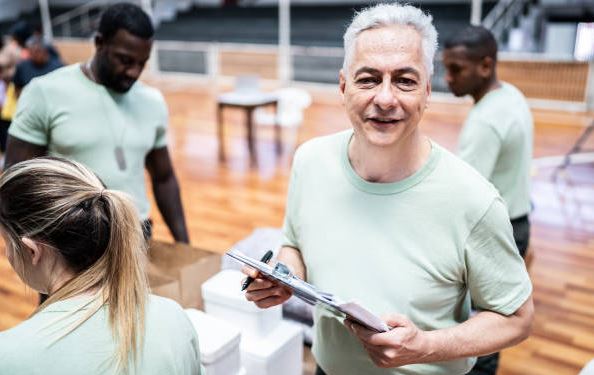Welcome to our blog post on Affordable Gym Access for Low-Income Communities! Staying fit and healthy has become more critical in today’s fast-paced world. However, access to gyms and fitness facilities can often be a financial challenge for those in low-income communities. But worry not, because we are here to shed light on free gym membership for low income and assistance programs that can make exercise accessible to everyone, regardless of their income level. So let’s dive in and explore the beautiful options available for affordable gym access!
Gym Access For Low-Income Communities
Contents
When discussing affordable gym access for low-income communities, it’s essential to establish a clear definition. In this context, affordable gym access refers to the availability of free gym membership for low income for individuals and families who may not have the financial means to join traditional fitness centers.

Gyms that offer these types of programs understand the importance of making exercise accessible to everyone, regardless of their income level. They recognize that physical activity is crucial in maintaining good health and overall well-being.
Free or reduced-cost memberships are often made available through partnerships between gyms and various organizations, such as non-profits, government agencies, or community centers. These partnerships help subsidize the cost of membership fees so that individuals from low-income communities can enjoy the benefits of regular exercise without breaking their budget.
These programs aim to eliminate barriers that prevent people from engaging in physical activity by providing affordable gym access. This goes beyond just having a place to work out – it also includes access to equipment, classes, personal trainers, and other resources necessary for individuals to achieve their fitness goals.
Defining affordable gym access is about creating opportunities for those who may otherwise be unable to afford traditional free gym membership for low income. It’s about leveling the playing field and ensuring everyone has equal chances at leading healthy lifestyles through regular exercise.
Free Or Reduced-Cost Memberships
Free or reduced-cost memberships are crucial to making gym access affordable for low-income communities. These programs aim to remove financial barriers often preventing individuals and families from joining fitness centers. By offering discounted or even free memberships, gyms can ensure that everyone has the opportunity to prioritize their health and well-being.
Many gyms partner with local organizations or government agencies to provide these low-income assistance programs. These partnerships help identify those in need and determine eligibility criteria for free gym membership for low income discounts. In some cases, individuals may need to provide proof of income or participate in certain community service activities to qualify for reduced-cost memberships.
These programs make it financially feasible for low-income individuals to join gyms and provide additional support such as personal training sessions, nutrition counseling, and wellness workshops. This holistic approach helps empower individuals with the knowledge and resources to lead healthier lifestyles despite limited financial means.
By offering affordable gym access, these programs have the potential to impact the physical and mental well-being of low-income communities positively. Regular exercise has been proven to reduce the risk of chronic diseases like obesity, diabetes, heart disease, and depression. Accessible fitness facilities allow people to engage in physical activity regularly without breaking their budgets.
Moreover, joining a gym provides opportunities for social interaction and sense of community among members. Exercise classes or group workouts foster connections between participants who share similar goals – improving overall health while creating a supportive network.
If you are interested in taking advantage of free or reduced-cost memberships offered by local gyms in your area, here are a few tips:
1) Research: Find out which gyms near you offer such programs by reaching out directly or conducting an online search.
2) Eligibility: Familiarize yourself with the eligibility requirements set by each program so you can gather any necessary documents if needed.
3) Application Process: Follow the application process provided by each gym carefully.
4) Utilize Other Resources: In addition to gym memberships, explore other community
Low-income assistance programs
Accessing affordable gym memberships can be challenging for individuals and families living on a low income. However, low-income assistance programs are available that aim to provide access to fitness facilities at reduced or no cost.

These programs are designed to ensure that everyone has the opportunity to improve their health and well-being through exercise. They partner with local gyms and fitness centers to offer free or discounted memberships for individuals and families who meet specific income criteria.
To qualify for these programs, applicants must demonstrate their financial need by providing proof of income or participation in other assistance programs such as food stamps or Medicaid. Once approved, participants access a range of amenities, including state-of-the-art equipment, group classes, personal training options, and more.
These assistance programs’ primary goal is not just physical fitness but also creating opportunities for social engagement and improving mental well-being. Many individuals from low-income communities face barriers like lack of transportation, limited resources, or unsafe neighborhoods, making it difficult for them to prioritize their health. These programs aim to break down those barriers by offering safe spaces where they can focus on themselves without worrying about the cost.
By making free gym membership for low income more accessible for low-income communities, these assistance programs are essential in promoting overall wellness. Regular exercise has been proven as one of the most effective ways to reduce the risk of chronic diseases like heart disease and diabetes while also boosting mental health.
In addition to physical benefits like weight management and increased energy levels, regular exercise can also improve sleep quality and cognitive function. It provides an outlet for stress relief while boosting self-esteem through achieving personal goals.
If you are part of a low-income community seeking affordable gym access, reach out locally or search online for organizations offering assistance programs near you. Take advantage of these opportunities for your physical health and to build stronger connections within your community.
Remember that your health is invaluable, and resources are available to help you prioritize it.
Why Gyms Are Important?
Gyms play a crucial role in promoting physical and mental well-being. They provide a dedicated space for people to exercise regularly, essential for maintaining good health. Whether lifting weights, running on a treadmill, or participating in group classes, gyms offer various options to suit different fitness goals and preferences.
One of the main benefits of going to the gym is access to specialized equipment that may not be available at home. From resistance machines to cardio equipment like ellipticals and stationary bikes, gyms provide tools that can help individuals target specific muscle groups or improve cardiovascular endurance.
In addition to the physical benefits, gyms also serve as social hubs where like-minded individuals gather with shared objectives. This sense of community creates accountability and motivation among members who encourage each other to stay consistent with their workout routines.
Furthermore, joining a gym often means gaining access to experienced trainers who can guide individuals through personalized workouts tailored to their needs and goals. These professionals can teach proper form and technique while providing valuable nutrition and wellness advice.
Regular exercise has been proven repeatedly to have numerous positive effects on physical and mental health. It helps reduce the risk of chronic diseases such as heart disease, diabetes, obesity, and certain types of cancer. Exercise also releases endorphins that boost mood levels by reducing stress levels and combatting symptoms associated with depression.
The Benefits Of Exercise
Regular exercise offers a multitude of benefits for both the body and mind. First and foremost, it helps to improve overall physical health. Regular physical activity can help strengthen muscles, increase cardiovascular endurance, and improve flexibility and balance.
Exercise also plays a crucial role in maintaining a healthy weight. It helps to burn calories and fat, leading to weight loss or maintenance. Regular exercise and a balanced diet are vital for achieving long-term weight management goals.
Furthermore, exercise has been linked to improved mental well-being. Physical activity releases endorphins which act as natural mood boosters, reducing feelings of stress and anxiety. Regular workouts can enhance cognitive function by improving memory and focus.
In addition to these immediate benefits, regular exercise can have long-term effects on overall health. It lowers the risk of chronic diseases such as heart disease, type 2 diabetes, and certain types of cancer.
Incorporating exercise into your daily routine is essential for maintaining good physical health and promoting mental well-being. Whether going for a walk or joining a low-cost gym program tailored towards low-income communities – any form of movement counts! So get moving today and reap the countless benefits of regular exercise!
Tips For Getting Started
1. Start Small: If you are new to exercise or haven’t been active, it’s essential to start small and gradually increase your intensity. Begin with short workouts or activities you enjoy and can easily incorporate into your daily routine.

2. Set Realistic Goals: Setting realistic goals is crucial to staying motivated and avoiding disappointment. Instead of aiming for drastic weight loss or muscle gain, focus on improving your overall health and well-being. Celebrate small victories along the way to keep yourself motivated.
3. Find a Workout Buddy: Exercising with a friend or family member makes workouts more enjoyable and provides accountability and support. Look for someone who shares similar fitness goals and interests, so you can motivate each other on this journey.
4. Explore Community Programs: Many low-income communities offer free or discounted fitness programs through local community centers, schools, or non-profit organizations. Take advantage of these resources as they often provide access to gym equipment, group classes, trainers, and other valuable services.
5. Utilize Online Resources: In today’s digital age, countless online resources are available at little to no cost to help you get started with an exercise routine. From workout videos on YouTube to fitness apps that track your progress – there is something out there for everyone.
Remember that consistency is critical when seeing results from your efforts. Stay committed to making regular physical activity a part of your lifestyle by finding activities you enjoy and incorporating them into your daily routine!
Conclusion
Affordable gym access for low-income communities is crucial in promoting health and well-being among individuals who may not have the financial means to join traditional gyms. Free gym membership for low income and low-income assistance programs plays a vital role in ensuring everyone has an equal opportunity to exercise and improve their physical fitness. Regular exercise has numerous benefits, both physically and mentally. It can help reduce the risk of chronic diseases such as heart disease, diabetes, and obesity. Exercise also boosts mood, reduces stress levels, improves sleep quality, increases energy levels, and enhances overall quality of life. Other options are available if you are part of a low-income community looking to get started with exercise but don’t have access to nearby gym facilities. Look for local community centers or recreational facilities that offer free or subsidized fitness classes or open gym hours. You can also explore outdoor activities like walking or jogging in your neighborhood park.
